Business Law Report: UK Business Types, Laws, Director/Auditor Duties
VerifiedAdded on 2022/11/30
|11
|2963
|62
Report
AI Summary
This report analyzes business law, focusing on different types of business organizations like sole traders, partnerships, and companies, particularly private and public limited companies. It details the steps involved in forming a limited company. The report then explores various laws, including employment law (Employment Rights Act, Employment Relations Act, and Employment Act), the National Minimum Wages Act, the Data Protection Act and GDPR, the Health and Safety at Workplace Act, and the Equality and Diversity Act. It also discusses the responsibilities of company directors and auditors, including their fiduciary duties and reporting obligations. Finally, the report addresses the responsibilities of a company when raising capital during company meetings and shareholders' meetings, emphasizing the importance of shareholder rights and the maximization of capital investment value. This is a crucial report for understanding the legal framework of businesses.
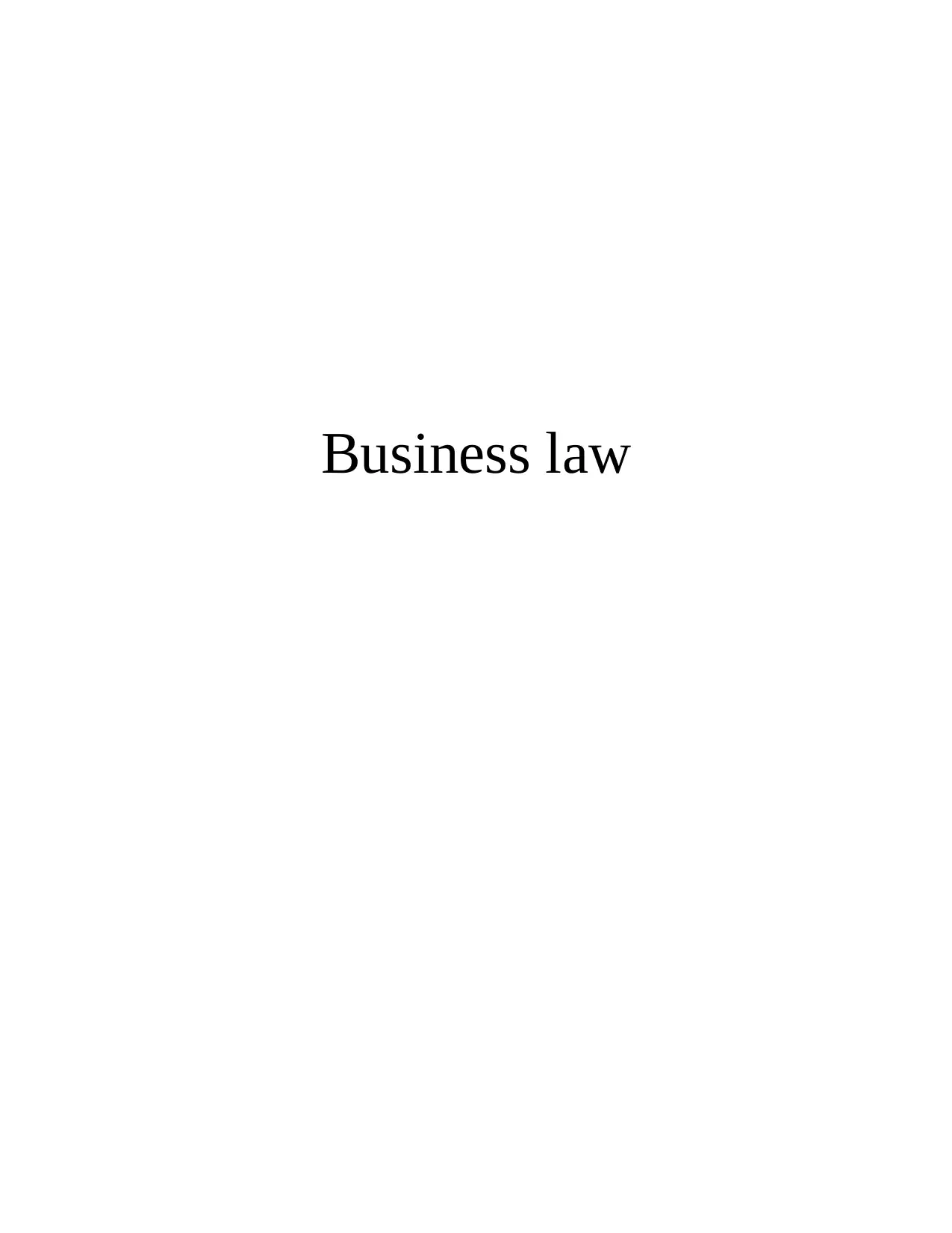
Business law
Paraphrase This Document
Need a fresh take? Get an instant paraphrase of this document with our AI Paraphraser
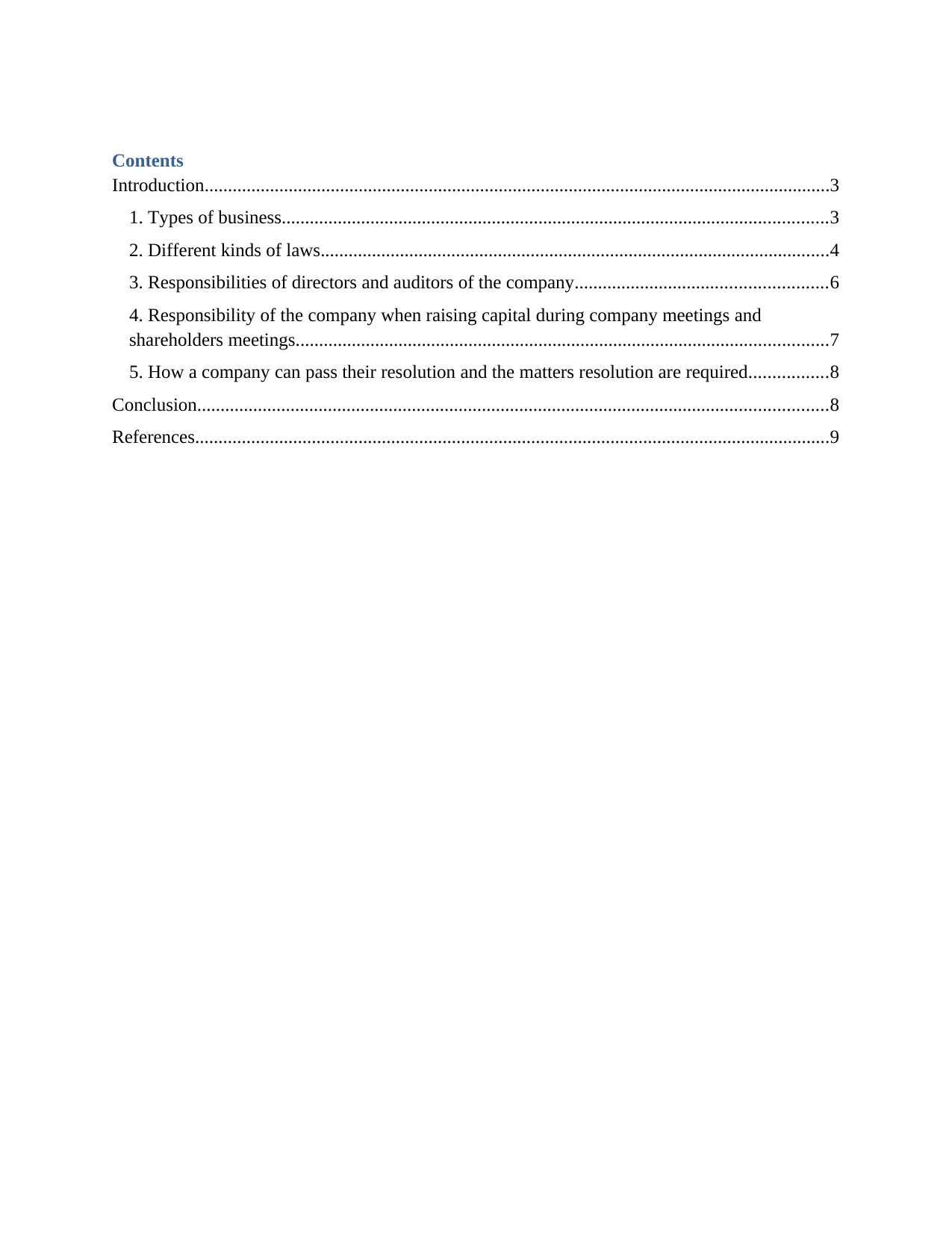
Contents
Introduction......................................................................................................................................3
1. Types of business.....................................................................................................................3
2. Different kinds of laws.............................................................................................................4
3. Responsibilities of directors and auditors of the company......................................................6
4. Responsibility of the company when raising capital during company meetings and
shareholders meetings..................................................................................................................7
5. How a company can pass their resolution and the matters resolution are required.................8
Conclusion.......................................................................................................................................8
References........................................................................................................................................9
Introduction......................................................................................................................................3
1. Types of business.....................................................................................................................3
2. Different kinds of laws.............................................................................................................4
3. Responsibilities of directors and auditors of the company......................................................6
4. Responsibility of the company when raising capital during company meetings and
shareholders meetings..................................................................................................................7
5. How a company can pass their resolution and the matters resolution are required.................8
Conclusion.......................................................................................................................................8
References........................................................................................................................................9
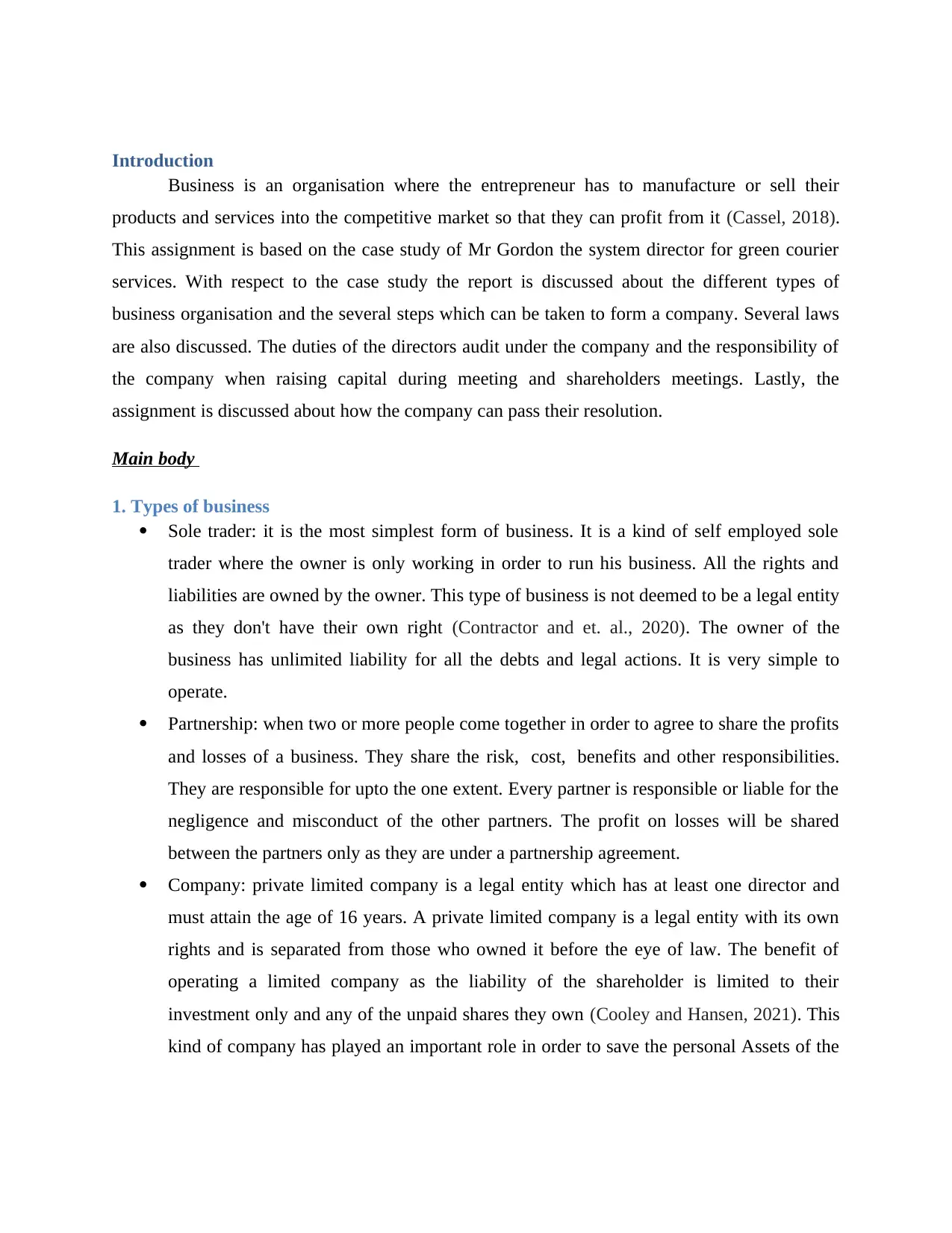
Introduction
Business is an organisation where the entrepreneur has to manufacture or sell their
products and services into the competitive market so that they can profit from it (Cassel, 2018).
This assignment is based on the case study of Mr Gordon the system director for green courier
services. With respect to the case study the report is discussed about the different types of
business organisation and the several steps which can be taken to form a company. Several laws
are also discussed. The duties of the directors audit under the company and the responsibility of
the company when raising capital during meeting and shareholders meetings. Lastly, the
assignment is discussed about how the company can pass their resolution.
Main body
1. Types of business
Sole trader: it is the most simplest form of business. It is a kind of self employed sole
trader where the owner is only working in order to run his business. All the rights and
liabilities are owned by the owner. This type of business is not deemed to be a legal entity
as they don't have their own right (Contractor and et. al., 2020). The owner of the
business has unlimited liability for all the debts and legal actions. It is very simple to
operate.
Partnership: when two or more people come together in order to agree to share the profits
and losses of a business. They share the risk, cost, benefits and other responsibilities.
They are responsible for upto the one extent. Every partner is responsible or liable for the
negligence and misconduct of the other partners. The profit on losses will be shared
between the partners only as they are under a partnership agreement.
Company: private limited company is a legal entity which has at least one director and
must attain the age of 16 years. A private limited company is a legal entity with its own
rights and is separated from those who owned it before the eye of law. The benefit of
operating a limited company as the liability of the shareholder is limited to their
investment only and any of the unpaid shares they own (Cooley and Hansen, 2021). This
kind of company has played an important role in order to save the personal Assets of the
Business is an organisation where the entrepreneur has to manufacture or sell their
products and services into the competitive market so that they can profit from it (Cassel, 2018).
This assignment is based on the case study of Mr Gordon the system director for green courier
services. With respect to the case study the report is discussed about the different types of
business organisation and the several steps which can be taken to form a company. Several laws
are also discussed. The duties of the directors audit under the company and the responsibility of
the company when raising capital during meeting and shareholders meetings. Lastly, the
assignment is discussed about how the company can pass their resolution.
Main body
1. Types of business
Sole trader: it is the most simplest form of business. It is a kind of self employed sole
trader where the owner is only working in order to run his business. All the rights and
liabilities are owned by the owner. This type of business is not deemed to be a legal entity
as they don't have their own right (Contractor and et. al., 2020). The owner of the
business has unlimited liability for all the debts and legal actions. It is very simple to
operate.
Partnership: when two or more people come together in order to agree to share the profits
and losses of a business. They share the risk, cost, benefits and other responsibilities.
They are responsible for upto the one extent. Every partner is responsible or liable for the
negligence and misconduct of the other partners. The profit on losses will be shared
between the partners only as they are under a partnership agreement.
Company: private limited company is a legal entity which has at least one director and
must attain the age of 16 years. A private limited company is a legal entity with its own
rights and is separated from those who owned it before the eye of law. The benefit of
operating a limited company as the liability of the shareholder is limited to their
investment only and any of the unpaid shares they own (Cooley and Hansen, 2021). This
kind of company has played an important role in order to save the personal Assets of the
⊘ This is a preview!⊘
Do you want full access?
Subscribe today to unlock all pages.

Trusted by 1+ million students worldwide
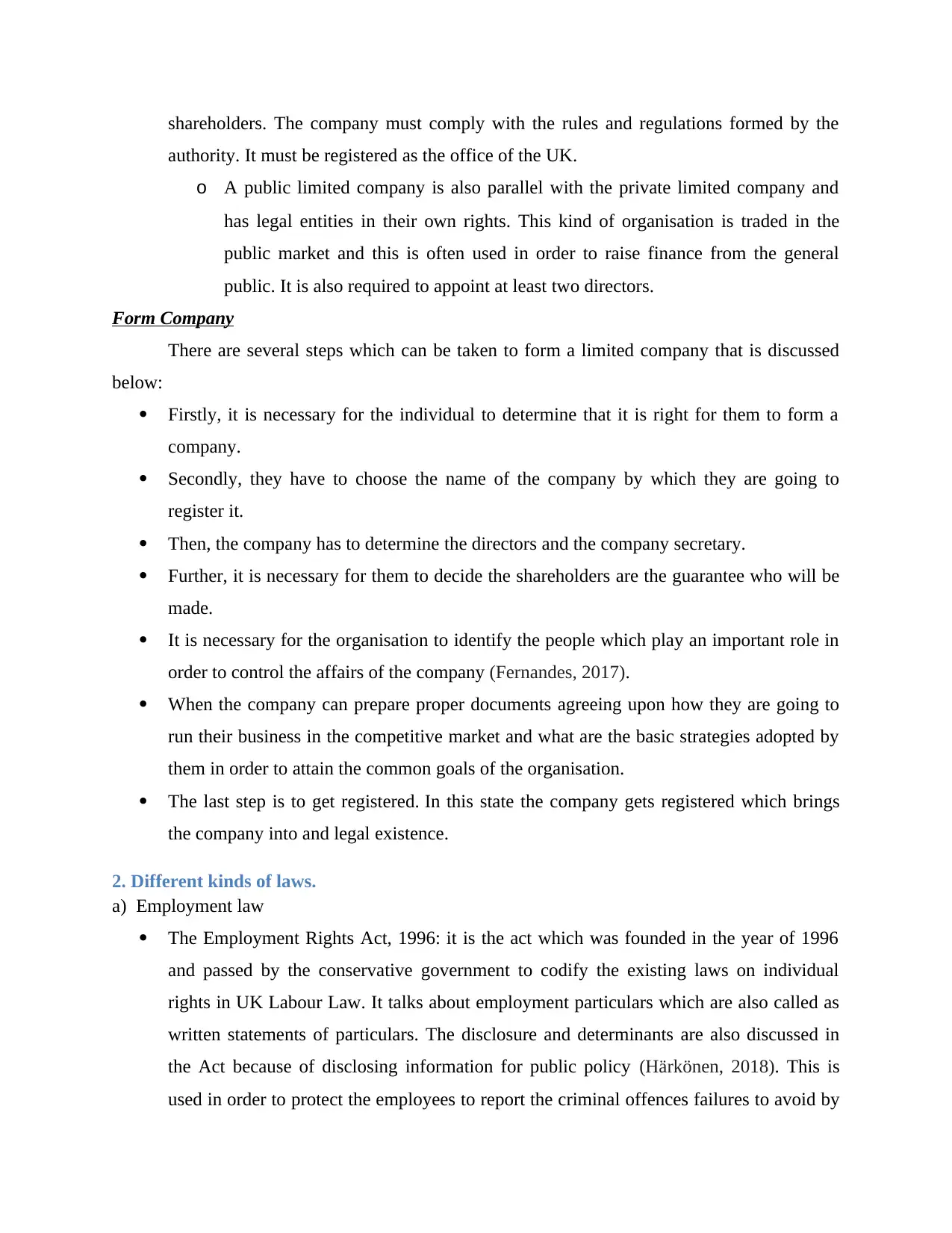
shareholders. The company must comply with the rules and regulations formed by the
authority. It must be registered as the office of the UK.
o A public limited company is also parallel with the private limited company and
has legal entities in their own rights. This kind of organisation is traded in the
public market and this is often used in order to raise finance from the general
public. It is also required to appoint at least two directors.
Form Company
There are several steps which can be taken to form a limited company that is discussed
below:
Firstly, it is necessary for the individual to determine that it is right for them to form a
company.
Secondly, they have to choose the name of the company by which they are going to
register it.
Then, the company has to determine the directors and the company secretary.
Further, it is necessary for them to decide the shareholders are the guarantee who will be
made.
It is necessary for the organisation to identify the people which play an important role in
order to control the affairs of the company (Fernandes, 2017).
When the company can prepare proper documents agreeing upon how they are going to
run their business in the competitive market and what are the basic strategies adopted by
them in order to attain the common goals of the organisation.
The last step is to get registered. In this state the company gets registered which brings
the company into and legal existence.
2. Different kinds of laws.
a) Employment law
The Employment Rights Act, 1996: it is the act which was founded in the year of 1996
and passed by the conservative government to codify the existing laws on individual
rights in UK Labour Law. It talks about employment particulars which are also called as
written statements of particulars. The disclosure and determinants are also discussed in
the Act because of disclosing information for public policy (Härkönen, 2018). This is
used in order to protect the employees to report the criminal offences failures to avoid by
authority. It must be registered as the office of the UK.
o A public limited company is also parallel with the private limited company and
has legal entities in their own rights. This kind of organisation is traded in the
public market and this is often used in order to raise finance from the general
public. It is also required to appoint at least two directors.
Form Company
There are several steps which can be taken to form a limited company that is discussed
below:
Firstly, it is necessary for the individual to determine that it is right for them to form a
company.
Secondly, they have to choose the name of the company by which they are going to
register it.
Then, the company has to determine the directors and the company secretary.
Further, it is necessary for them to decide the shareholders are the guarantee who will be
made.
It is necessary for the organisation to identify the people which play an important role in
order to control the affairs of the company (Fernandes, 2017).
When the company can prepare proper documents agreeing upon how they are going to
run their business in the competitive market and what are the basic strategies adopted by
them in order to attain the common goals of the organisation.
The last step is to get registered. In this state the company gets registered which brings
the company into and legal existence.
2. Different kinds of laws.
a) Employment law
The Employment Rights Act, 1996: it is the act which was founded in the year of 1996
and passed by the conservative government to codify the existing laws on individual
rights in UK Labour Law. It talks about employment particulars which are also called as
written statements of particulars. The disclosure and determinants are also discussed in
the Act because of disclosing information for public policy (Härkönen, 2018). This is
used in order to protect the employees to report the criminal offences failures to avoid by
Paraphrase This Document
Need a fresh take? Get an instant paraphrase of this document with our AI Paraphraser
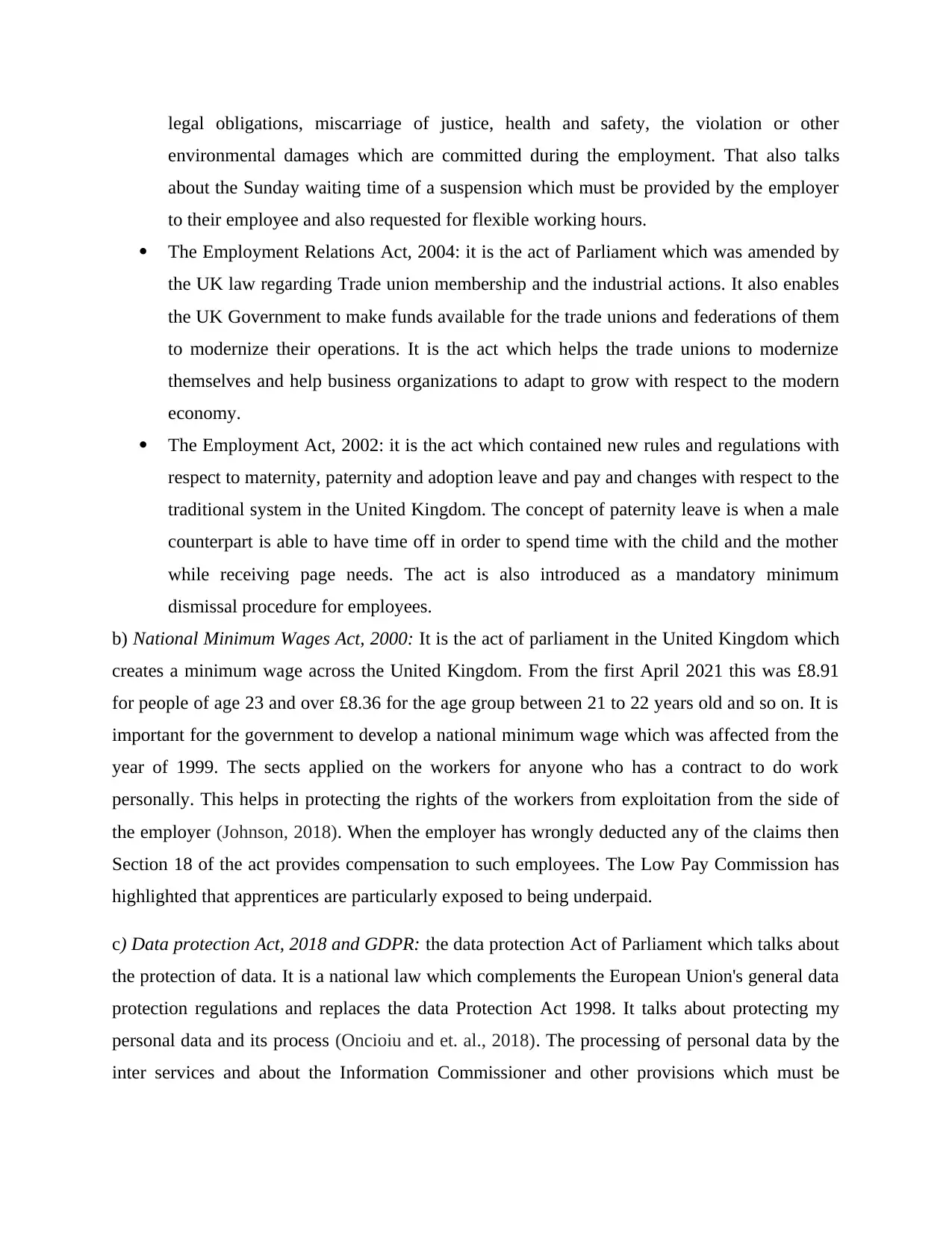
legal obligations, miscarriage of justice, health and safety, the violation or other
environmental damages which are committed during the employment. That also talks
about the Sunday waiting time of a suspension which must be provided by the employer
to their employee and also requested for flexible working hours.
The Employment Relations Act, 2004: it is the act of Parliament which was amended by
the UK law regarding Trade union membership and the industrial actions. It also enables
the UK Government to make funds available for the trade unions and federations of them
to modernize their operations. It is the act which helps the trade unions to modernize
themselves and help business organizations to adapt to grow with respect to the modern
economy.
The Employment Act, 2002: it is the act which contained new rules and regulations with
respect to maternity, paternity and adoption leave and pay and changes with respect to the
traditional system in the United Kingdom. The concept of paternity leave is when a male
counterpart is able to have time off in order to spend time with the child and the mother
while receiving page needs. The act is also introduced as a mandatory minimum
dismissal procedure for employees.
b) National Minimum Wages Act, 2000: It is the act of parliament in the United Kingdom which
creates a minimum wage across the United Kingdom. From the first April 2021 this was £8.91
for people of age 23 and over £8.36 for the age group between 21 to 22 years old and so on. It is
important for the government to develop a national minimum wage which was affected from the
year of 1999. The sects applied on the workers for anyone who has a contract to do work
personally. This helps in protecting the rights of the workers from exploitation from the side of
the employer (Johnson, 2018). When the employer has wrongly deducted any of the claims then
Section 18 of the act provides compensation to such employees. The Low Pay Commission has
highlighted that apprentices are particularly exposed to being underpaid.
c) Data protection Act, 2018 and GDPR: the data protection Act of Parliament which talks about
the protection of data. It is a national law which complements the European Union's general data
protection regulations and replaces the data Protection Act 1998. It talks about protecting my
personal data and its process (Oncioiu and et. al., 2018). The processing of personal data by the
inter services and about the Information Commissioner and other provisions which must be
environmental damages which are committed during the employment. That also talks
about the Sunday waiting time of a suspension which must be provided by the employer
to their employee and also requested for flexible working hours.
The Employment Relations Act, 2004: it is the act of Parliament which was amended by
the UK law regarding Trade union membership and the industrial actions. It also enables
the UK Government to make funds available for the trade unions and federations of them
to modernize their operations. It is the act which helps the trade unions to modernize
themselves and help business organizations to adapt to grow with respect to the modern
economy.
The Employment Act, 2002: it is the act which contained new rules and regulations with
respect to maternity, paternity and adoption leave and pay and changes with respect to the
traditional system in the United Kingdom. The concept of paternity leave is when a male
counterpart is able to have time off in order to spend time with the child and the mother
while receiving page needs. The act is also introduced as a mandatory minimum
dismissal procedure for employees.
b) National Minimum Wages Act, 2000: It is the act of parliament in the United Kingdom which
creates a minimum wage across the United Kingdom. From the first April 2021 this was £8.91
for people of age 23 and over £8.36 for the age group between 21 to 22 years old and so on. It is
important for the government to develop a national minimum wage which was affected from the
year of 1999. The sects applied on the workers for anyone who has a contract to do work
personally. This helps in protecting the rights of the workers from exploitation from the side of
the employer (Johnson, 2018). When the employer has wrongly deducted any of the claims then
Section 18 of the act provides compensation to such employees. The Low Pay Commission has
highlighted that apprentices are particularly exposed to being underpaid.
c) Data protection Act, 2018 and GDPR: the data protection Act of Parliament which talks about
the protection of data. It is a national law which complements the European Union's general data
protection regulations and replaces the data Protection Act 1998. It talks about protecting my
personal data and its process (Oncioiu and et. al., 2018). The processing of personal data by the
inter services and about the Information Commissioner and other provisions which must be
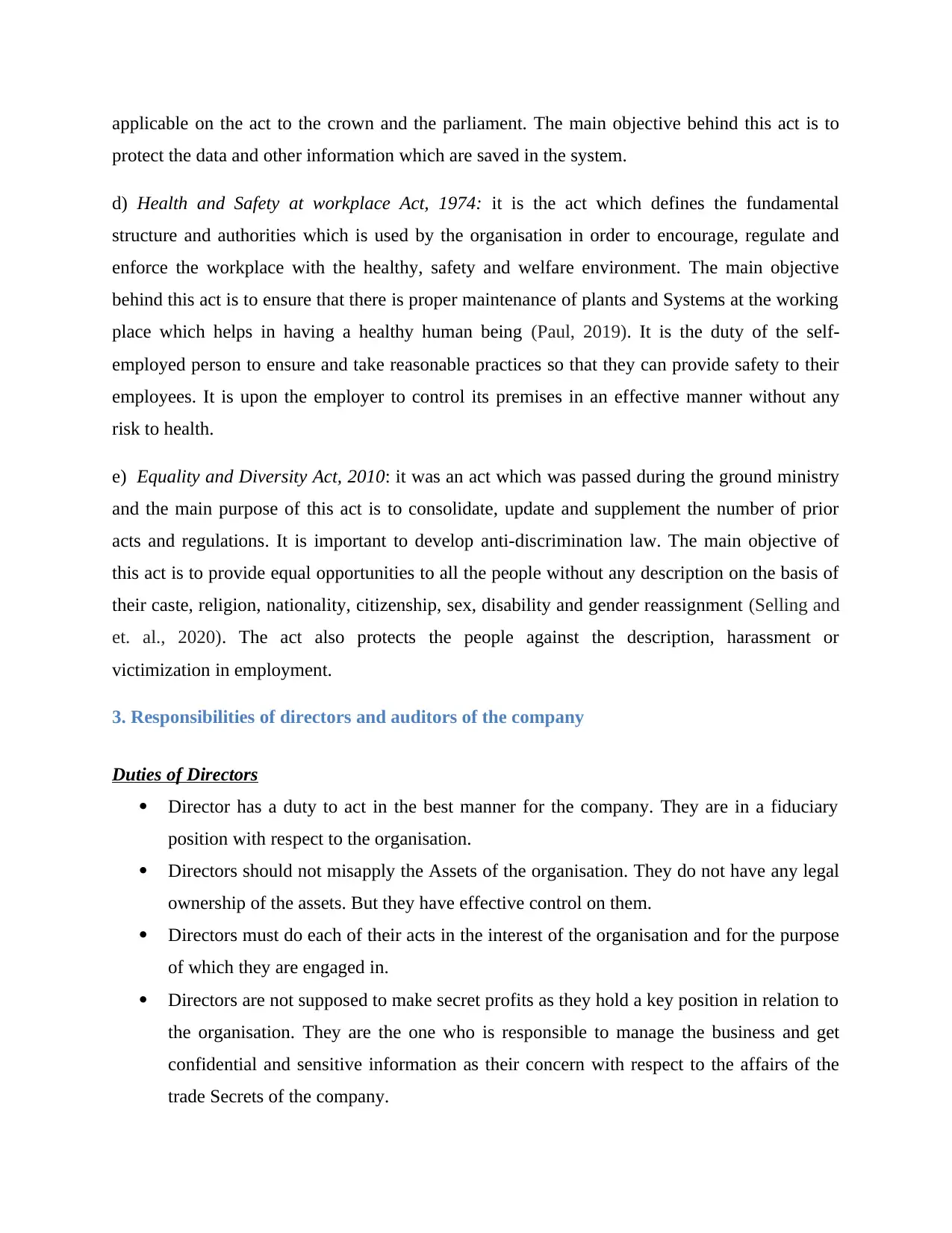
applicable on the act to the crown and the parliament. The main objective behind this act is to
protect the data and other information which are saved in the system.
d) Health and Safety at workplace Act, 1974: it is the act which defines the fundamental
structure and authorities which is used by the organisation in order to encourage, regulate and
enforce the workplace with the healthy, safety and welfare environment. The main objective
behind this act is to ensure that there is proper maintenance of plants and Systems at the working
place which helps in having a healthy human being (Paul, 2019). It is the duty of the self-
employed person to ensure and take reasonable practices so that they can provide safety to their
employees. It is upon the employer to control its premises in an effective manner without any
risk to health.
e) Equality and Diversity Act, 2010: it was an act which was passed during the ground ministry
and the main purpose of this act is to consolidate, update and supplement the number of prior
acts and regulations. It is important to develop anti-discrimination law. The main objective of
this act is to provide equal opportunities to all the people without any description on the basis of
their caste, religion, nationality, citizenship, sex, disability and gender reassignment (Selling and
et. al., 2020). The act also protects the people against the description, harassment or
victimization in employment.
3. Responsibilities of directors and auditors of the company
Duties of Directors
Director has a duty to act in the best manner for the company. They are in a fiduciary
position with respect to the organisation.
Directors should not misapply the Assets of the organisation. They do not have any legal
ownership of the assets. But they have effective control on them.
Directors must do each of their acts in the interest of the organisation and for the purpose
of which they are engaged in.
Directors are not supposed to make secret profits as they hold a key position in relation to
the organisation. They are the one who is responsible to manage the business and get
confidential and sensitive information as their concern with respect to the affairs of the
trade Secrets of the company.
protect the data and other information which are saved in the system.
d) Health and Safety at workplace Act, 1974: it is the act which defines the fundamental
structure and authorities which is used by the organisation in order to encourage, regulate and
enforce the workplace with the healthy, safety and welfare environment. The main objective
behind this act is to ensure that there is proper maintenance of plants and Systems at the working
place which helps in having a healthy human being (Paul, 2019). It is the duty of the self-
employed person to ensure and take reasonable practices so that they can provide safety to their
employees. It is upon the employer to control its premises in an effective manner without any
risk to health.
e) Equality and Diversity Act, 2010: it was an act which was passed during the ground ministry
and the main purpose of this act is to consolidate, update and supplement the number of prior
acts and regulations. It is important to develop anti-discrimination law. The main objective of
this act is to provide equal opportunities to all the people without any description on the basis of
their caste, religion, nationality, citizenship, sex, disability and gender reassignment (Selling and
et. al., 2020). The act also protects the people against the description, harassment or
victimization in employment.
3. Responsibilities of directors and auditors of the company
Duties of Directors
Director has a duty to act in the best manner for the company. They are in a fiduciary
position with respect to the organisation.
Directors should not misapply the Assets of the organisation. They do not have any legal
ownership of the assets. But they have effective control on them.
Directors must do each of their acts in the interest of the organisation and for the purpose
of which they are engaged in.
Directors are not supposed to make secret profits as they hold a key position in relation to
the organisation. They are the one who is responsible to manage the business and get
confidential and sensitive information as their concern with respect to the affairs of the
trade Secrets of the company.
⊘ This is a preview!⊘
Do you want full access?
Subscribe today to unlock all pages.

Trusted by 1+ million students worldwide

Paraphrase This Document
Need a fresh take? Get an instant paraphrase of this document with our AI Paraphraser
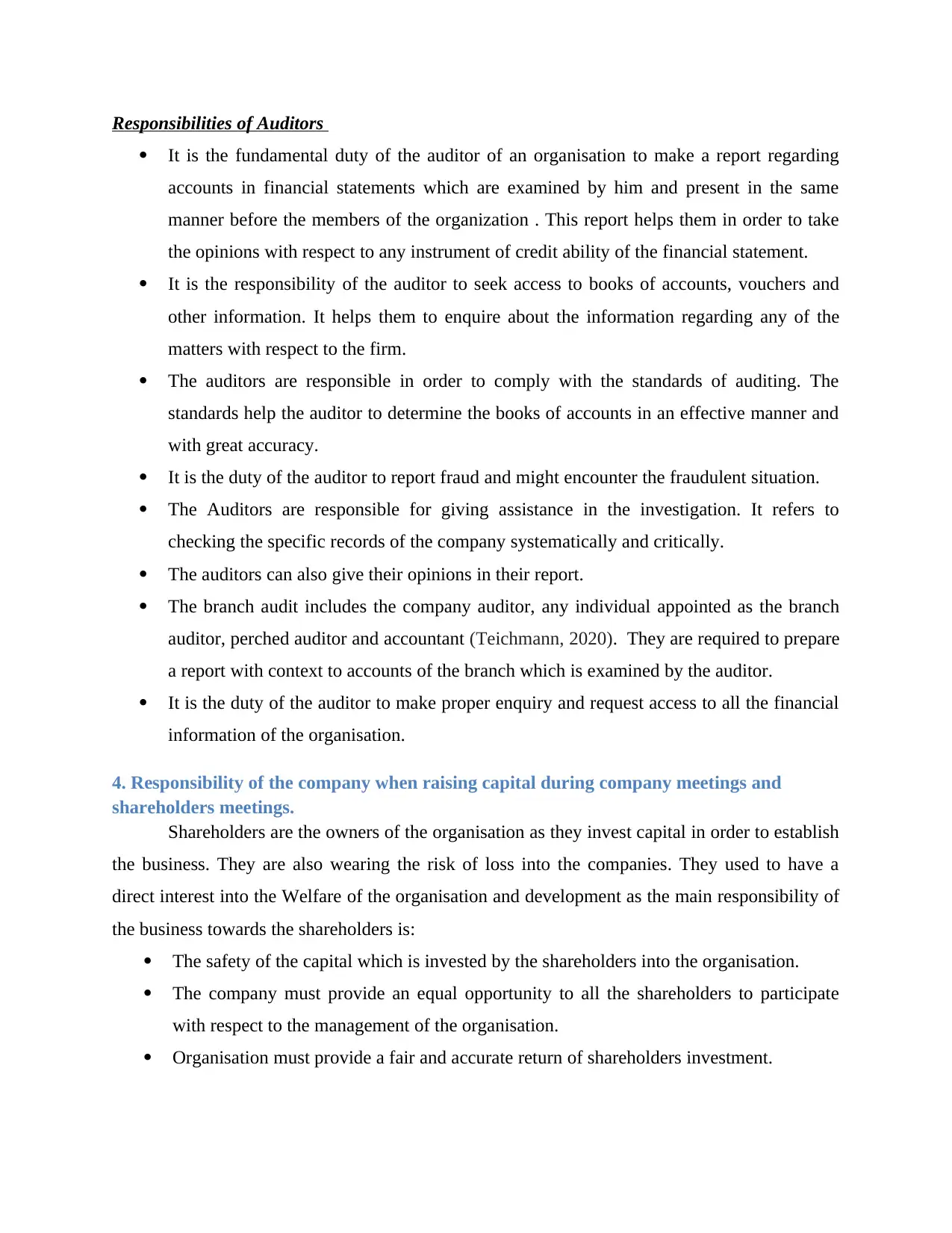
Responsibilities of Auditors
It is the fundamental duty of the auditor of an organisation to make a report regarding
accounts in financial statements which are examined by him and present in the same
manner before the members of the organization . This report helps them in order to take
the opinions with respect to any instrument of credit ability of the financial statement.
It is the responsibility of the auditor to seek access to books of accounts, vouchers and
other information. It helps them to enquire about the information regarding any of the
matters with respect to the firm.
The auditors are responsible in order to comply with the standards of auditing. The
standards help the auditor to determine the books of accounts in an effective manner and
with great accuracy.
It is the duty of the auditor to report fraud and might encounter the fraudulent situation.
The Auditors are responsible for giving assistance in the investigation. It refers to
checking the specific records of the company systematically and critically.
The auditors can also give their opinions in their report.
The branch audit includes the company auditor, any individual appointed as the branch
auditor, perched auditor and accountant (Teichmann, 2020). They are required to prepare
a report with context to accounts of the branch which is examined by the auditor.
It is the duty of the auditor to make proper enquiry and request access to all the financial
information of the organisation.
4. Responsibility of the company when raising capital during company meetings and
shareholders meetings.
Shareholders are the owners of the organisation as they invest capital in order to establish
the business. They are also wearing the risk of loss into the companies. They used to have a
direct interest into the Welfare of the organisation and development as the main responsibility of
the business towards the shareholders is:
The safety of the capital which is invested by the shareholders into the organisation.
The company must provide an equal opportunity to all the shareholders to participate
with respect to the management of the organisation.
Organisation must provide a fair and accurate return of shareholders investment.
It is the fundamental duty of the auditor of an organisation to make a report regarding
accounts in financial statements which are examined by him and present in the same
manner before the members of the organization . This report helps them in order to take
the opinions with respect to any instrument of credit ability of the financial statement.
It is the responsibility of the auditor to seek access to books of accounts, vouchers and
other information. It helps them to enquire about the information regarding any of the
matters with respect to the firm.
The auditors are responsible in order to comply with the standards of auditing. The
standards help the auditor to determine the books of accounts in an effective manner and
with great accuracy.
It is the duty of the auditor to report fraud and might encounter the fraudulent situation.
The Auditors are responsible for giving assistance in the investigation. It refers to
checking the specific records of the company systematically and critically.
The auditors can also give their opinions in their report.
The branch audit includes the company auditor, any individual appointed as the branch
auditor, perched auditor and accountant (Teichmann, 2020). They are required to prepare
a report with context to accounts of the branch which is examined by the auditor.
It is the duty of the auditor to make proper enquiry and request access to all the financial
information of the organisation.
4. Responsibility of the company when raising capital during company meetings and
shareholders meetings.
Shareholders are the owners of the organisation as they invest capital in order to establish
the business. They are also wearing the risk of loss into the companies. They used to have a
direct interest into the Welfare of the organisation and development as the main responsibility of
the business towards the shareholders is:
The safety of the capital which is invested by the shareholders into the organisation.
The company must provide an equal opportunity to all the shareholders to participate
with respect to the management of the organisation.
Organisation must provide a fair and accurate return of shareholders investment.
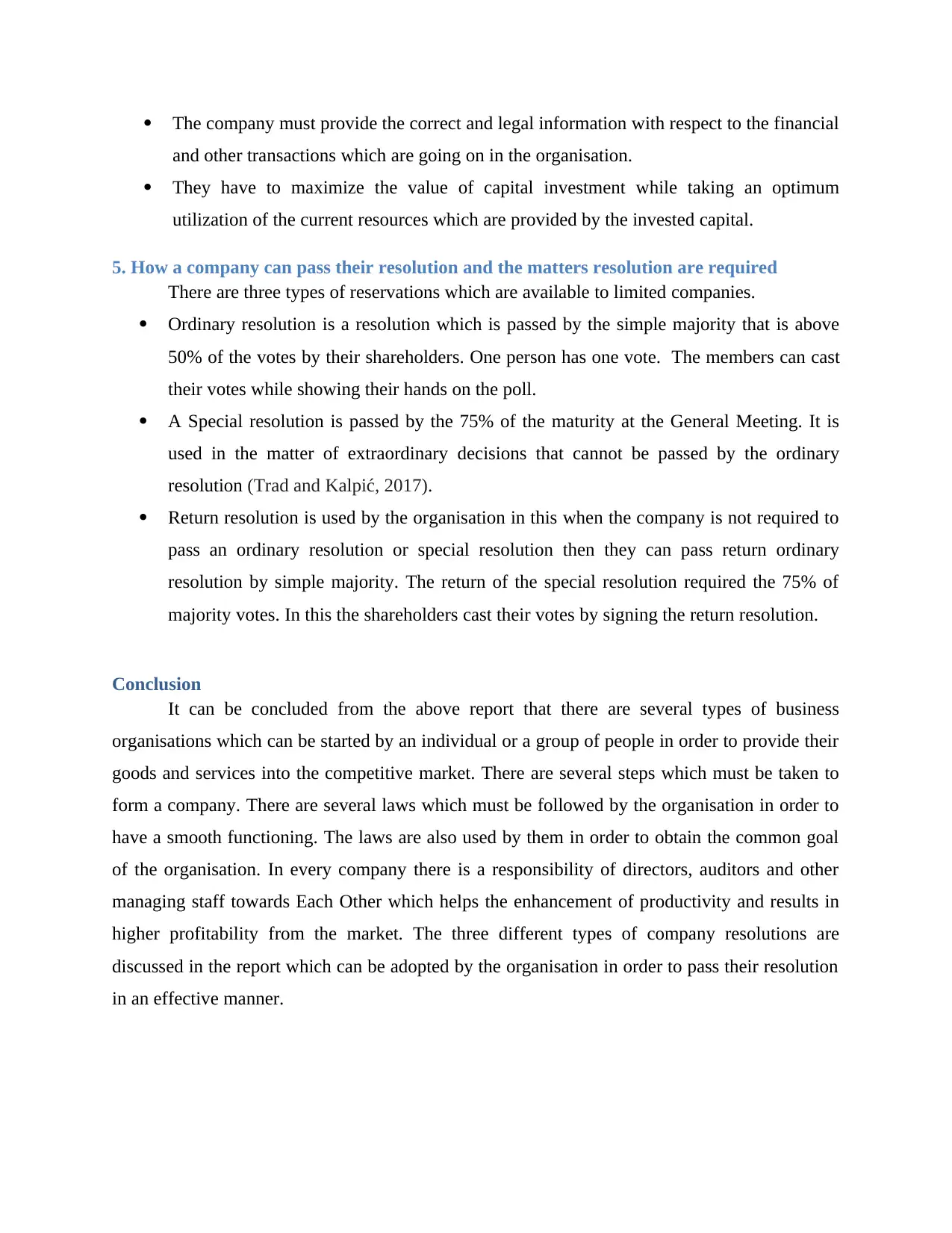
The company must provide the correct and legal information with respect to the financial
and other transactions which are going on in the organisation.
They have to maximize the value of capital investment while taking an optimum
utilization of the current resources which are provided by the invested capital.
5. How a company can pass their resolution and the matters resolution are required
There are three types of reservations which are available to limited companies.
Ordinary resolution is a resolution which is passed by the simple majority that is above
50% of the votes by their shareholders. One person has one vote. The members can cast
their votes while showing their hands on the poll.
A Special resolution is passed by the 75% of the maturity at the General Meeting. It is
used in the matter of extraordinary decisions that cannot be passed by the ordinary
resolution (Trad and Kalpić, 2017).
Return resolution is used by the organisation in this when the company is not required to
pass an ordinary resolution or special resolution then they can pass return ordinary
resolution by simple majority. The return of the special resolution required the 75% of
majority votes. In this the shareholders cast their votes by signing the return resolution.
Conclusion
It can be concluded from the above report that there are several types of business
organisations which can be started by an individual or a group of people in order to provide their
goods and services into the competitive market. There are several steps which must be taken to
form a company. There are several laws which must be followed by the organisation in order to
have a smooth functioning. The laws are also used by them in order to obtain the common goal
of the organisation. In every company there is a responsibility of directors, auditors and other
managing staff towards Each Other which helps the enhancement of productivity and results in
higher profitability from the market. The three different types of company resolutions are
discussed in the report which can be adopted by the organisation in order to pass their resolution
in an effective manner.
and other transactions which are going on in the organisation.
They have to maximize the value of capital investment while taking an optimum
utilization of the current resources which are provided by the invested capital.
5. How a company can pass their resolution and the matters resolution are required
There are three types of reservations which are available to limited companies.
Ordinary resolution is a resolution which is passed by the simple majority that is above
50% of the votes by their shareholders. One person has one vote. The members can cast
their votes while showing their hands on the poll.
A Special resolution is passed by the 75% of the maturity at the General Meeting. It is
used in the matter of extraordinary decisions that cannot be passed by the ordinary
resolution (Trad and Kalpić, 2017).
Return resolution is used by the organisation in this when the company is not required to
pass an ordinary resolution or special resolution then they can pass return ordinary
resolution by simple majority. The return of the special resolution required the 75% of
majority votes. In this the shareholders cast their votes by signing the return resolution.
Conclusion
It can be concluded from the above report that there are several types of business
organisations which can be started by an individual or a group of people in order to provide their
goods and services into the competitive market. There are several steps which must be taken to
form a company. There are several laws which must be followed by the organisation in order to
have a smooth functioning. The laws are also used by them in order to obtain the common goal
of the organisation. In every company there is a responsibility of directors, auditors and other
managing staff towards Each Other which helps the enhancement of productivity and results in
higher profitability from the market. The three different types of company resolutions are
discussed in the report which can be adopted by the organisation in order to pass their resolution
in an effective manner.
⊘ This is a preview!⊘
Do you want full access?
Subscribe today to unlock all pages.

Trusted by 1+ million students worldwide
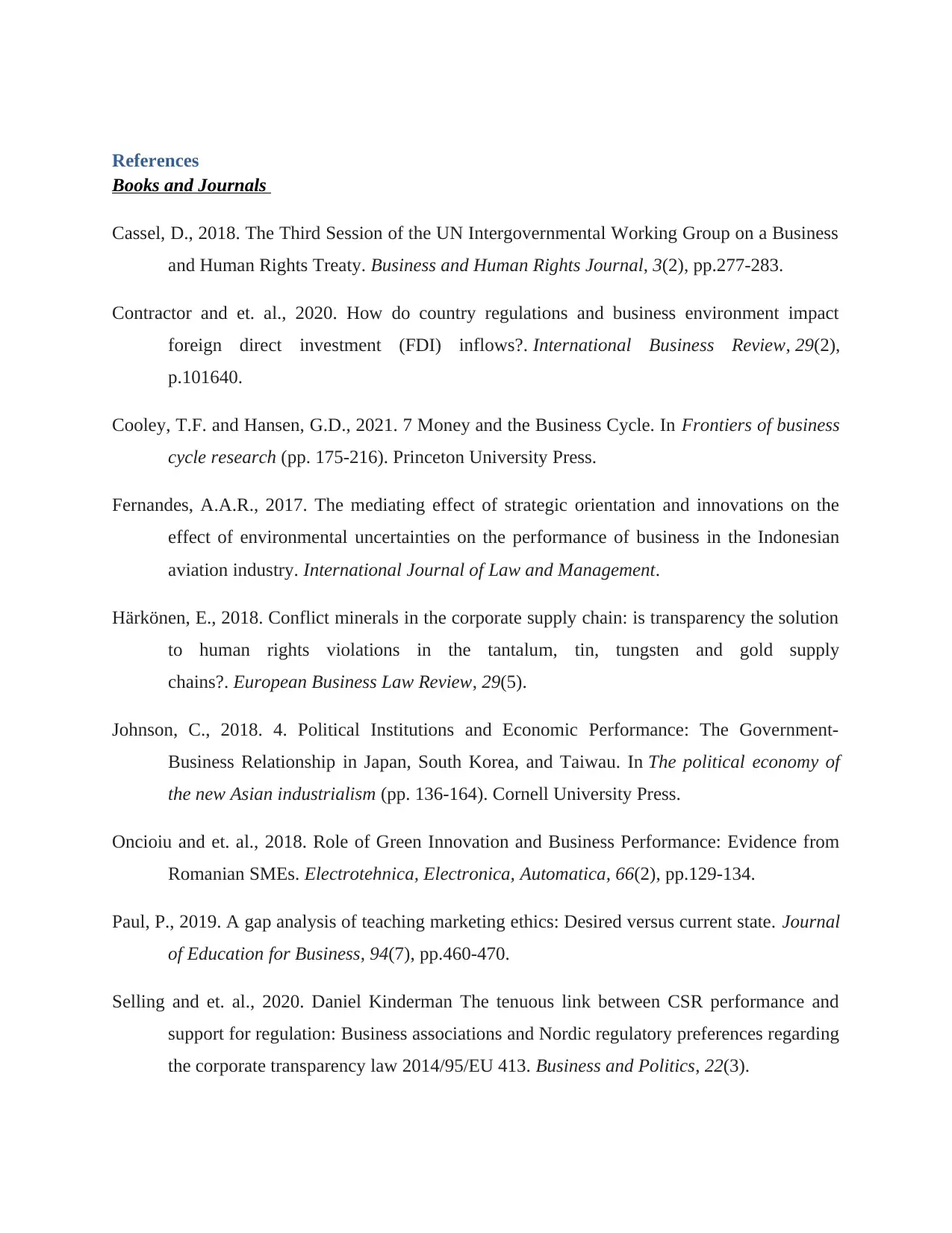
References
Books and Journals
Cassel, D., 2018. The Third Session of the UN Intergovernmental Working Group on a Business
and Human Rights Treaty. Business and Human Rights Journal, 3(2), pp.277-283.
Contractor and et. al., 2020. How do country regulations and business environment impact
foreign direct investment (FDI) inflows?. International Business Review, 29(2),
p.101640.
Cooley, T.F. and Hansen, G.D., 2021. 7 Money and the Business Cycle. In Frontiers of business
cycle research (pp. 175-216). Princeton University Press.
Fernandes, A.A.R., 2017. The mediating effect of strategic orientation and innovations on the
effect of environmental uncertainties on the performance of business in the Indonesian
aviation industry. International Journal of Law and Management.
Härkönen, E., 2018. Conflict minerals in the corporate supply chain: is transparency the solution
to human rights violations in the tantalum, tin, tungsten and gold supply
chains?. European Business Law Review, 29(5).
Johnson, C., 2018. 4. Political Institutions and Economic Performance: The Government-
Business Relationship in Japan, South Korea, and Taiwau. In The political economy of
the new Asian industrialism (pp. 136-164). Cornell University Press.
Oncioiu and et. al., 2018. Role of Green Innovation and Business Performance: Evidence from
Romanian SMEs. Electrotehnica, Electronica, Automatica, 66(2), pp.129-134.
Paul, P., 2019. A gap analysis of teaching marketing ethics: Desired versus current state. Journal
of Education for Business, 94(7), pp.460-470.
Selling and et. al., 2020. Daniel Kinderman The tenuous link between CSR performance and
support for regulation: Business associations and Nordic regulatory preferences regarding
the corporate transparency law 2014/95/EU 413. Business and Politics, 22(3).
Books and Journals
Cassel, D., 2018. The Third Session of the UN Intergovernmental Working Group on a Business
and Human Rights Treaty. Business and Human Rights Journal, 3(2), pp.277-283.
Contractor and et. al., 2020. How do country regulations and business environment impact
foreign direct investment (FDI) inflows?. International Business Review, 29(2),
p.101640.
Cooley, T.F. and Hansen, G.D., 2021. 7 Money and the Business Cycle. In Frontiers of business
cycle research (pp. 175-216). Princeton University Press.
Fernandes, A.A.R., 2017. The mediating effect of strategic orientation and innovations on the
effect of environmental uncertainties on the performance of business in the Indonesian
aviation industry. International Journal of Law and Management.
Härkönen, E., 2018. Conflict minerals in the corporate supply chain: is transparency the solution
to human rights violations in the tantalum, tin, tungsten and gold supply
chains?. European Business Law Review, 29(5).
Johnson, C., 2018. 4. Political Institutions and Economic Performance: The Government-
Business Relationship in Japan, South Korea, and Taiwau. In The political economy of
the new Asian industrialism (pp. 136-164). Cornell University Press.
Oncioiu and et. al., 2018. Role of Green Innovation and Business Performance: Evidence from
Romanian SMEs. Electrotehnica, Electronica, Automatica, 66(2), pp.129-134.
Paul, P., 2019. A gap analysis of teaching marketing ethics: Desired versus current state. Journal
of Education for Business, 94(7), pp.460-470.
Selling and et. al., 2020. Daniel Kinderman The tenuous link between CSR performance and
support for regulation: Business associations and Nordic regulatory preferences regarding
the corporate transparency law 2014/95/EU 413. Business and Politics, 22(3).
Paraphrase This Document
Need a fresh take? Get an instant paraphrase of this document with our AI Paraphraser
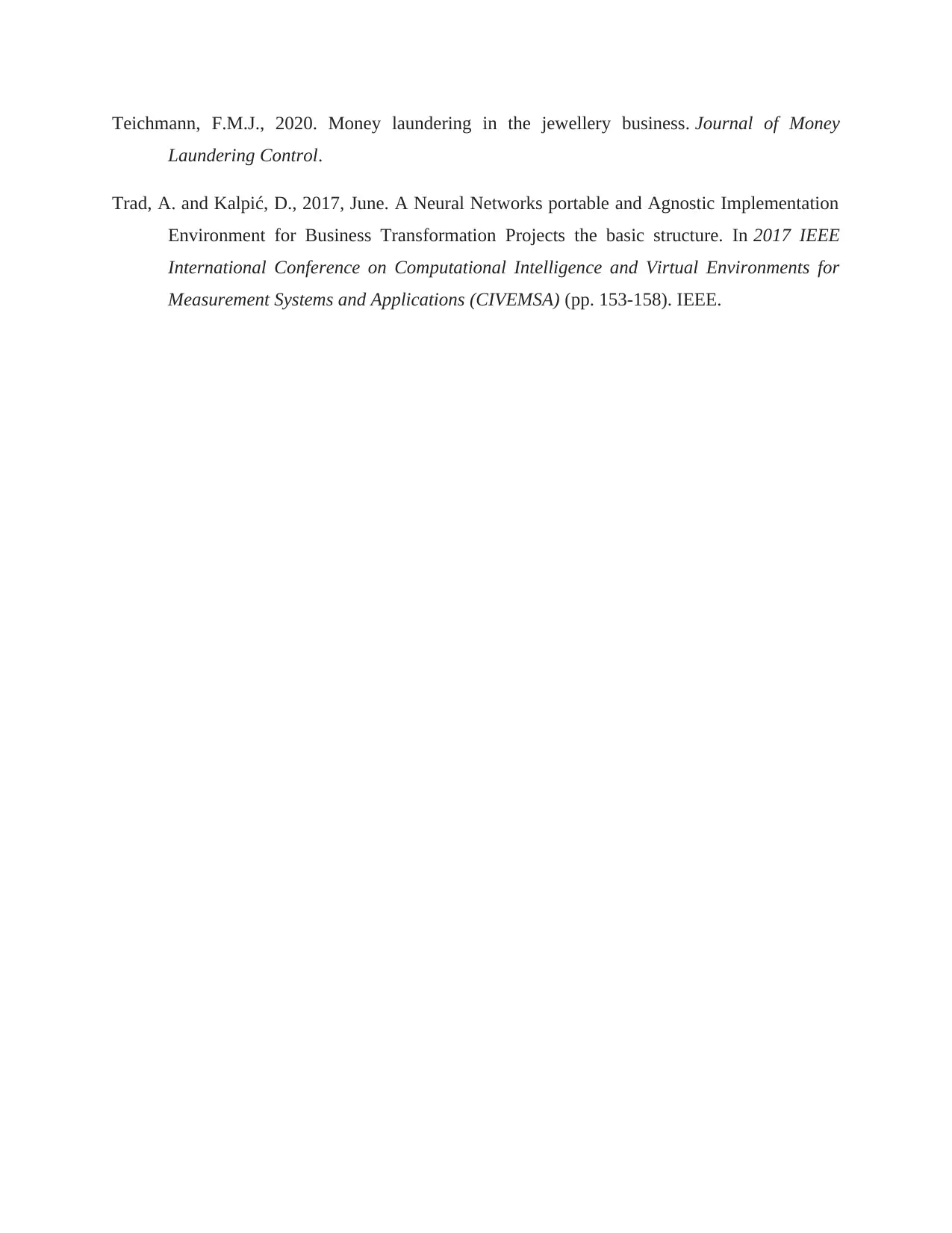
Teichmann, F.M.J., 2020. Money laundering in the jewellery business. Journal of Money
Laundering Control.
Trad, A. and Kalpić, D., 2017, June. A Neural Networks portable and Agnostic Implementation
Environment for Business Transformation Projects the basic structure. In 2017 IEEE
International Conference on Computational Intelligence and Virtual Environments for
Measurement Systems and Applications (CIVEMSA) (pp. 153-158). IEEE.
Laundering Control.
Trad, A. and Kalpić, D., 2017, June. A Neural Networks portable and Agnostic Implementation
Environment for Business Transformation Projects the basic structure. In 2017 IEEE
International Conference on Computational Intelligence and Virtual Environments for
Measurement Systems and Applications (CIVEMSA) (pp. 153-158). IEEE.
1 out of 11
Related Documents
Your All-in-One AI-Powered Toolkit for Academic Success.
+13062052269
info@desklib.com
Available 24*7 on WhatsApp / Email
![[object Object]](/_next/static/media/star-bottom.7253800d.svg)
Unlock your academic potential
Copyright © 2020–2025 A2Z Services. All Rights Reserved. Developed and managed by ZUCOL.




